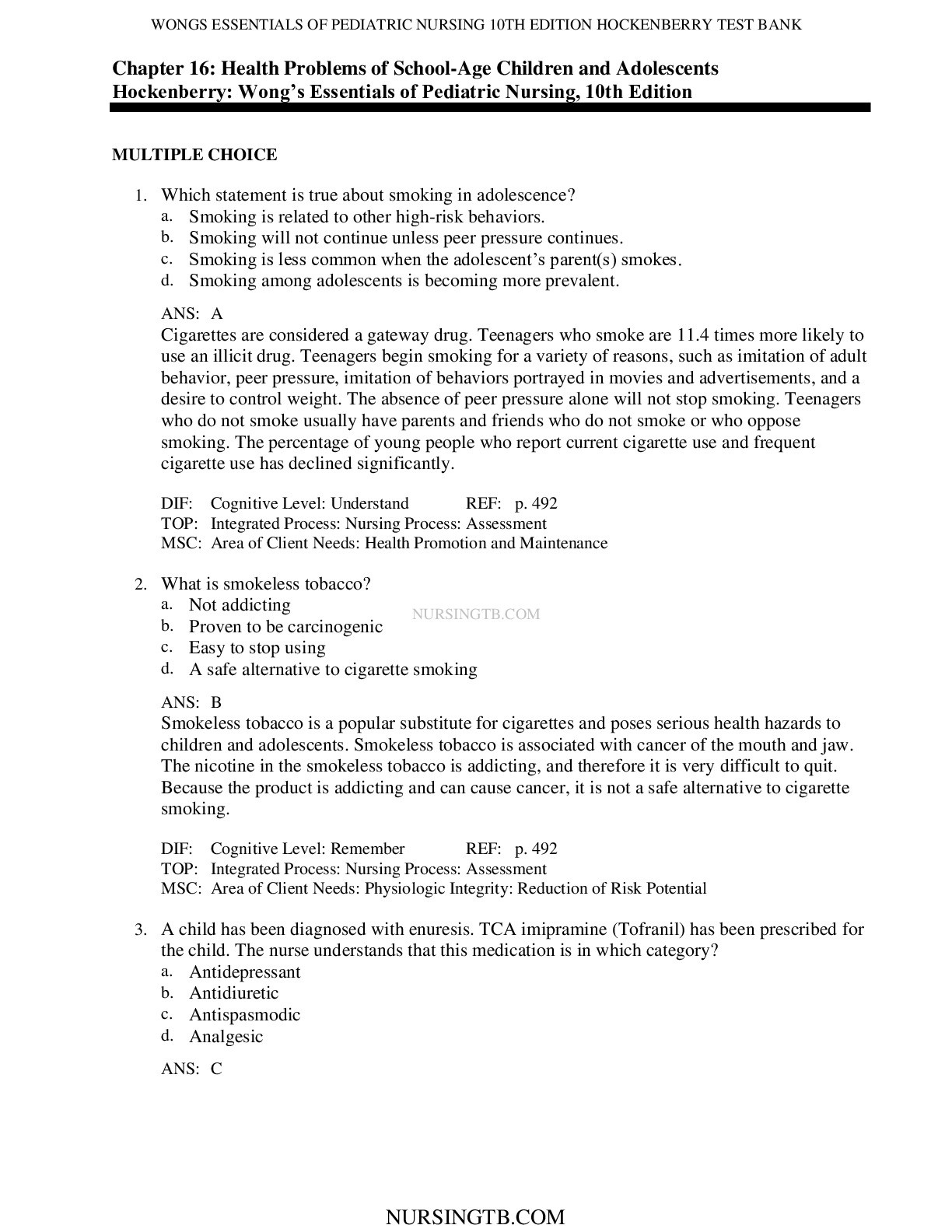All study resources > Chapter 16: Health Problems of School-Age Children and AdolescentsHockenberry: Wong’s Essentials of Pediatric Nursing, 10th Edition (Nursing)
Chapter 16: Health Problems of School-Age Children and AdolescentsHockenberry: Wong’s Essentials of Pediatric Nursing, 10th Edition
1. Which statement is true about smoking in adolescence?
a. Smoking is related to other high-risk behaviors.
b. Smoking will not continue unless peer pressure continues.
c. Smoking is less common when the adolescent’s parent(s) smokes.
d. Smoking among adolescents is becoming more prevalent.
2. What is smokeless tobacco?
a. Not addicting
b. Proven to be carcinogenic
c. Easy to stop usi
...[Show More]
1. Which statement is true about smoking in adolescence?
a. Smoking is related to other high-risk behaviors.
b. Smoking will not continue unless peer pressure continues.
c. Smoking is less common when the adolescent’s parent(s) smokes.
d. Smoking among adolescents is becoming more prevalent.
2. What is smokeless tobacco?
a. Not addicting
b. Proven to be carcinogenic
c. Easy to stop using
d. A safe alternative to cigarette smoking
3. A child has been diagnosed with enuresis. TCA imipramine (Tofranil) has been prescribed for
the child. The nurse understands that this medication is in which category?
a. Antidepressant
b. Antidiuretic
c. Antispasmodic
d. Analgesic
4. A 12-year-old male has short stature because of a constitutional growth delay. What should
the nurse be the most concerned about?
a. Proper administration of thyroid hormone
b. Proper administration of human growth hormones
c. Child’s self-esteem and sense of competence
d. Helping child understand that his height is most likely caused by chronic illness
and is not his fault
5. An adolescent asks the nurse what causes primary dysmenorrhea. The nurse’s response should
be based on which statement?
a. It is an inherited problem.
b. Excessive estrogen production causes uterine pain.
c. There is no physiologic cause; it is a psychological reaction.
d. There is a relation between prostaglandins and uterine contractility.
6. An adolescent girl asks the school nurse for advice because she has dysmenorrhea. She says
that a friend recommended she try an over-the-counter nonsteroidal anti-inflammatory drug
(NSAID). The nurse’s response should be based on which statement?
a. Aspirin is the drug of choice for the treatment of dysmenorrhea.
b. Over-the-counter NSAIDs are rarely strong enough to provide adequate pain relief.
c. NSAIDs are effective because of their analgesic effect.
d. NSAIDs are effective because they inhibit prostaglandins, leading to reduction in
uterine activity.
7. A 14-year-old boy and his parents are concerned about bilateral breast enlargement. The
nurse’s discussion of this should be based on which statement?
a. This is usually benign and temporary.
b. This is usually caused by Klinefelter syndrome.
c. Administration of estrogen effectively reduces gynecomastia.
d. Administration of testosterone effectively reduces gynecomastia.
[Show Less]
